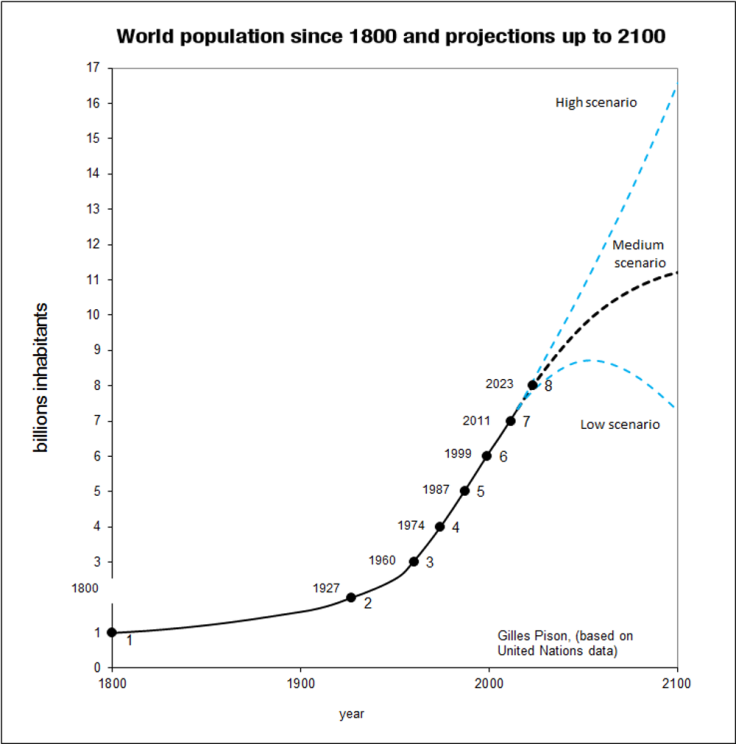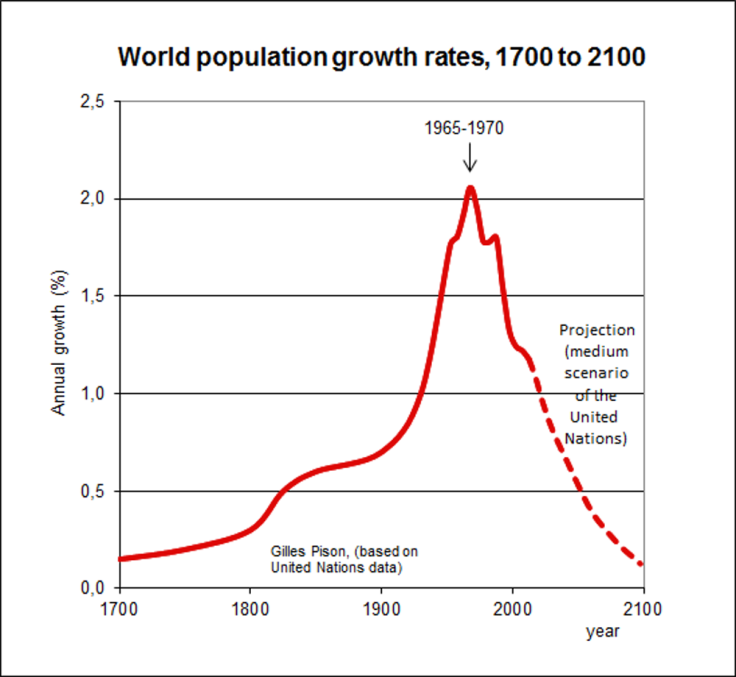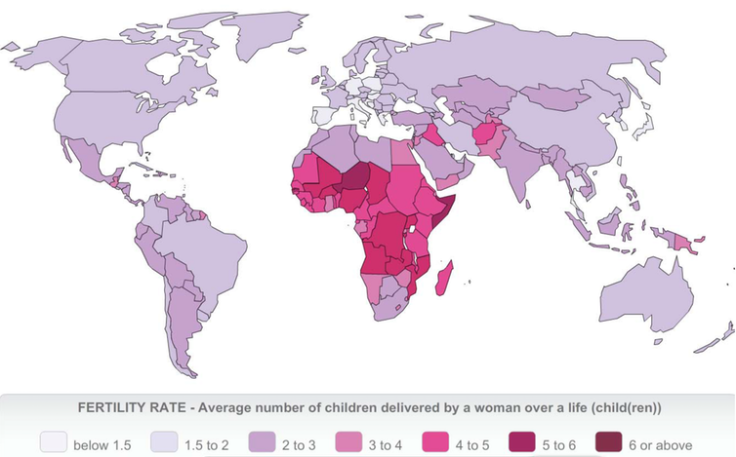There are now 7.5 billion people in the world. Is the Earth overpopulated?
The world's population is set to reach 10 billion by 2050.

In 1800 the world's population was around 1 billion people. Since then it has increased more than sevenfold to reach over 7.5 billion in 2017 (see figure 1), and is forecast to top 10 billion by 2050. Will population growth inevitably continue? Will it level off over the long term? Should we try to reduce or stop this growth?
Simply put, the world's population is increasing because the number of births outnumber deaths by three to one. A surplus of births first occurred two centuries ago in Europe and North America, when mortality started to decline. This marked the beginning of what scientists call the demographic transition. This transition subsequently spread to the rest of the planet as social and economic progress, combined with advances in hygiene and medicine, began to reduce mortality rates.
Rapid population growth in Africa
Still, the annual population growth rate actually peaked half a century ago at more than 2%, and has fallen by half since then, to 1.1% in 2017 (see figure 2). This trend should continue in coming decades because fertility is decreasing at global level, from 5 children per woman in 1950 to 2.5 today. In 2017, the regions where fertility remains high (above 3 children per woman) include most countries of intertropical Africa and an area stretching from Afghanistan to northern India and Pakistan (see map below). These are the regions that will drive future world population growth.

A key trend in future decades will be population growth in Africa. Including North Africa, the continent's population could quadruple over the next century, rising from 1 billion inhabitants in 2010 to an estimated 2.5 billion in 2050 and more than 4 billion in 2100, despite the negative impact of the AIDS epidemic and other factors. While, globally speaking, one person in six currently lives in Africa, the proportion will probably be more than one in three a century from now. Growth should be especially rapid in sub-Saharan Africa, where the population may rise from just over 800 million in 2010 to 4 billion in 2100.
What will happen in the coming decades?
These figures are projections, and no one can predict what the future will bring. That said, demographic projections are quite reliable for forecasting population size over the next 10, 20 or 30 years. Most of the people who will be alive in 2050 have already been born, their number is known and we can estimate quite accurately the proportion among those currently alive who will die. Likewise, the women who will bear children over the next 20 years are already alive today, and can be counted. By estimating their potential fertility we can determine the number of future births with relative accuracy.
It would be unrealistic to imagine that population trends can be modified over the short term. Depopulation is not an option. Indeed, how could it possibly be achieved? Through increased mortality? No one hopes for that. Through mass emigration to Mars? Unrealistic. Through a drastic and durable decrease in fertility to below replacement level (2.1 children)? This is already taking place in many parts of the world, as couples decide to have fewer children so as to give them the best chances for a long and fulfilling life.

But for reasons of demographic inertia, this does not result in an immediate population decline. Even if world fertility were just 1.6 children per women, as is the case in Europe and China, the population would continue to increase for several more decades; there are still large numbers of adults of childbearing age who were born when fertility was still high, so the number of births also remains high. The proportion of old and very old people is very small, on the other hand, so deaths are far less numerous.
The question of fertility decline
Demographers were taken by surprise in the 1960s and 1970s when surveys revealed the onset of a sharp decline in fertility in many countries of Asia and Latin America, and demographic projections for these regions of the world were revised strongly downward.
Another more recent surprise concerns intertropical Africa. Fertility decline in the region was expected to begin later than in Asia and Latin America because of slower social and economic development. But it was assumed that, while delayed, the transition would follow the standard pattern, with a decline similar to that observed in other regions of the Global South. This is indeed the case in North and southern Africa, but not in intertropical Africa, where the decline is occurring more slowly. This explains the upward revision of projections for Africa, a continent which could be home to more than a third of the world's population by 2100.

Fertility is in fact decreasing in intertropical Africa, but among the educated and urban populations and not in rural areas where most of the population still lives. While the fertility decline is still slower than that observed some decades ago in Asia and Latin America (see figure 4), the reason does not lie in an unwillingness to use contraception.
While most rural families have yet to adopt a two-child family model, they would prefer to have fewer children and to space them further apart. They are willing to use contraception for this purpose, but the necessary services are not available to them. National birth-control programmes exist but are ineffective because they lack resources and, above all, because their organisers and the personnel responsible for implementing them are unenthusiastic. Many are not convinced of the advantages of birth control, even at government level, even if this is not the official line adopted with respect to international organisations
This is one of the differences with respect to Asia and Latin America in the 1960s and 1970s, and one of the obstacles to faster fertility decline in sub-Saharan Africa.
Long-term outlook: explosion, implosion or equilibrium?
Beyond the next 50 years, however, the future is much more uncertain and there is no established forecasting model.
The demographic transition, which has served well to predict changes over the last two centuries, will be of little use for this distant future. There is much uncertainty about future fertility. If the small family becomes a dominant model over the long term, with mean fertility of less than two children per women, then the world population, after peaking at 10 billion, will gradually decrease to the point of extinction.

But another scenario is possible, in which fertility recovers in the countries where it is now very low, ultimately stabilising at more than two children per woman worldwide. This would result in continuous growth, and again in the extinction of the human race, this time due to overpopulation. If we cannot resign ourselves to these catastrophic scenarios of extinction through under- or over-population, then we must imagine a scenario of ultimate equilibrium.
It is lifestyle that matters
Of course, humans must start thinking today about the need for long-term equilibrium, but it is the next few decades that are of most urgent concern.
The world population will inevitably increase by 2 to 3 billion between now and 2050 because of demographic inertia that no one can prevent. Nonetheless, we have the power to change yet now our way of living – and there is an urgent need to do so – by ensuring greater respect for the environment and more efficient use of natural resources. All in all, the long-term survival of humankind depends more on its choice of lifestyle than on its population size.
Gilles Pison, is a professor anthropology and demography at the French National Museum of Natural History, part of Sorbonne Universities.
This article was originally published on The Conversation. Read the original article.





















